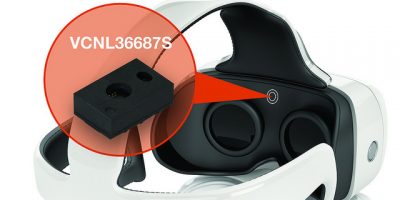Proximity sensor has range of 200mm for VR/AR headsets
Combining a high power vertical-cavity surface-emitting laser (VCSEL), a photodiode, a signal processing IC, and a 12bit ADC in a single package, Vishay Intertechnology has developed the VCNL36687S to be used in smartphones, tablets, virtual reality/augmented reality (VR/AR) headsets, and other battery-operated devices.
The VCNL36687S has a range of up to 200mm (7.9 inches), and simplifies the use and design-in of the proximity sensing capability in consumer and industrial applications because no mechanical barriers are required to optically isolate the emitter from the detector. The miniature, surface-mount 3.05 x 2.0mm leadless package (LLP) has a low profile of 1.0mm for a small footprint and low profile to suit space-constrained applications in mobile devices.
The VCNL36687S can be used to minimise accidental touch inputs on a smartphone that can lead to call drops and camera launch, or can be used to detect when a user is, or isn’t, wearing a VR/AR headset. The VCSEL’s profile of ± three degrees makes the VCNL36687S suitable for applications that require narrow angle detection and minimises optical system design concerns, adds Vishay.
Compared to previous generation devices, the VCNL36687S requires less energy to carry out the same functionality. It has a 20mA pulse current, enabling it to detect a Kodak Gray card at a distance of 200mm, where previous VCNL series devices required 200mA of current.
The standard I2C bus serial digital interface allows easy access to the proximity signal. The VCNL36687S’s programmable interrupt function offers wake-up functionality for the microcontroller when a proximity change occurs, which reduces processing overhead by eliminating the need for continuous polling.
Samples and production quantities of the VCNL36687S are available now, with lead times of 8 to 12 weeks.
Vishay Intertechnology claims to be one of the world’s largest manufacturers of discrete semiconductors (diodes, MOSFETs, and infrared optoelectronics) and passive electronic components (resistors, inductors, and capacitors). The components it produces are used in virtually all types of electronic devices and equipment, in the industrial, computing, automotive, consumer, telecommunications, military, aerospace, power supplies, and medical markets.




